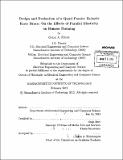Design and evaluation of a quasi-passive robotic knee brace : on the effects of parallel elasticity on human running
Author(s)
Elliott, Grant (Grant Andrew)
DownloadFull printable version (11.91Mb)
Other Contributors
Massachusetts Institute of Technology. Dept. of Electrical Engineering and Computer Science.
Advisor
Hugh Herr.
Terms of use
Metadata
Show full item recordAbstract
While the effects of series compliance on running biomechanics are documented, the effects of parallel compliance are known only for the simpler case of hopping. As many practical exoskeleton and orthosis designs act in parallel with the leg, it is desirable to understand the effects of such an intervention. Spring-like forces offer a natural choice of perturbation, as they are both biologically motivated and energetically inexpensive to implement. To this end, this thesis investigates the hypothesis that the addition of an external elastic element at the knee during the stance phase of running results in a reduction in knee extensor activation so that total joint quasi-stiffness is maintained. To test this, an exoskeleton is presented, consisting of a leaf spring in parallel with the knee joint and a clutch which engages this spring only during stance. The design of a custom interference clutch, made necessary by the need for high holding torque but low mass, is discussed in detail, as are problems of human attachment. The greater applicability of this clutch design to other problems in rehabilitation and augmentation is also addressed. Motion capture of four subjects is used to investigate the consequences of running with this exoskeleton. Leg stiffness is found to increase with distal mass, but no significant change in leg stiffness or total knee stiffness is observed due to the activation of the clutched parallel knee spring. However, preliminary evidence suggests differing responses between trained marathon runners, who appear to maintain biological knee torque, and recreational runners, who appear to maintain total knee torque. Such a relationship between degree of past training and effective utilization of an external force is suggestive of limitations on the applications of assistive devices.
Description
Thesis (Ph. D.)--Massachusetts Institute of Technology, Dept. of Electrical Engineering and Computer Science, 2012. Cataloged from PDF version of thesis. Includes bibliographical references (p. 103-106).
Date issued
2012Department
Massachusetts Institute of Technology. Department of Electrical Engineering and Computer SciencePublisher
Massachusetts Institute of Technology
Keywords
Electrical Engineering and Computer Science.